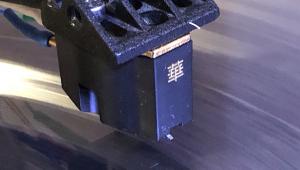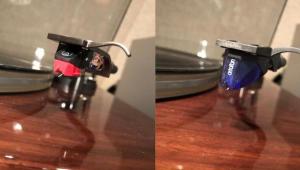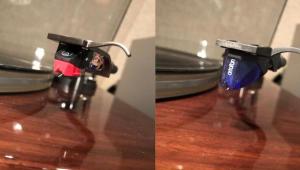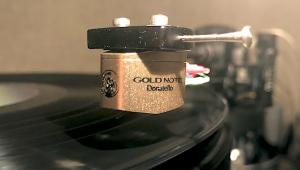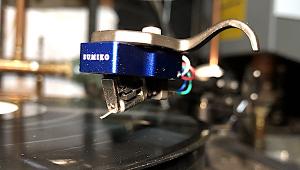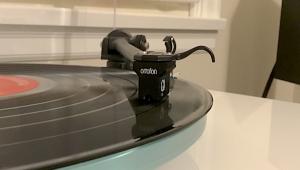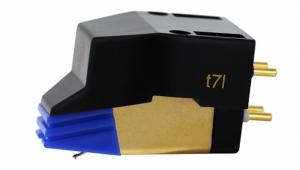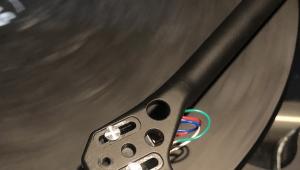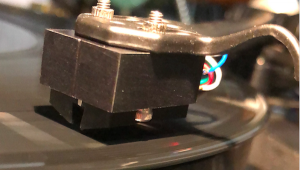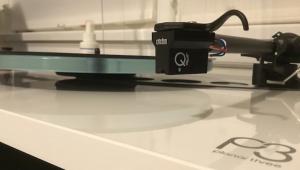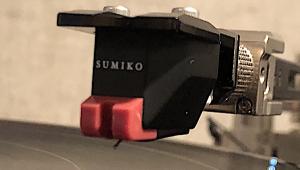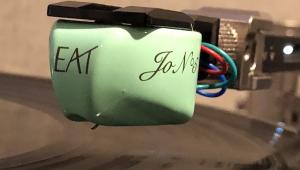AudioQuest 7000 Fe5 MC phono cartridge Page 3
But then won't the "stray" magnetic flux increase greatly, thus increasing distortion? Not according to Carr, who claims that two magnets operating in a push-pull, mode with the core in the center, results in both extremely low distortion and the efficient generation of electricity.
AudioQuest 7000 fe5
AudioQuest's 7000 Fe5 is not designed to be played with its body removed, nor does it feature "monoblock" construction or a cutaway body. But, Bill Low told me, that was taken into account in the final design. Why did Low make the decision to not have a removable body? Simple: Low was designing a different cartridge for a different end user. The best way to describe the difference between the two cartridges is to use a car analogy: The Clavis DC is the Dodge Intrepid; the AudioQuest 7000 Fe5 is the Chrysler New Yorker. Both are based on a similar design, but one is built for speed, the other comfort.
Low told me his goal was to forgo radical design in favor of predictable, bottom-line high performance, hence the Fe5's nonremovable body and its reasonably high output of 0.4mV. By taking advantage of Scan-Tech's precision manufacturing and its ability to custom combine various components, Low was able to get the design and sound he wanted.
For those listeners who find the Clavis too much to handle, the AudioQuest Fe5 provides greater bass dynamics, more low-end "oomph," more richness and warmth, and more overall sonic luxury. With its higher output, you feel more seat cushion and less of the road, you glide along on a much smoother highway of sound. It's an easier, more comfortable ride.
Right out of the box, the Fe5 was easier on the ears, sounding sumptuous, yet still detailed and bracing. The Fe5 was more forgiving of set-up variation; although, like the Clavis, it gave you the most in terms of focus, clarity, transient speed and inner detail when it was "locked-in." Break-in time was shorter—about 35 hours of play before I felt it really sang.
The Fe5 reproduces the upper octaves (ie, brass, cymbals, etc.) with an extremely attractive, listenable, and harmonically convincing burnished glow compared to the Da Capo's more aggressive take.
Lost in the warm glow, though, were the little cracks, and even some of the big potholes, which help reveal the inner textures and minute details and shadings of recordings, some good, some bad. Overall, however, the Fe5, sonically tailored by a careful listener like Low, provides a canny balance between exposure of fine recorded detail and the luxury that only fine analog can provide. This design should prove to be even more popular than the 7000 nsx—it improves on that fine design in every way.
Because of its higher output, I was careful to match levels when switching from the Clavis to the Fe5 and replaying records. On Clap Hands Here Comes Charlie (original or reissue), Fitzgerald's voice was warmer, fuller, and more mellow with the Fe5. Bass was better delineated and lines were easier to follow.
Somewhat harder to make out though, was the interplay between Lou Levy's piano and Herb Ellis's guitar: The two blended together. Some would say that's more likely what you'd hear live, that separating the two, as the Clavis does, is a function of overly detailed, "hyped-up" sound. I don't think there's a clear answer.
On Joan Baez in Concert, the Fe5 added a warm glow to Joan's voice which, while pleasant, robbed it of the "you-are-there" quality the Clavis gave it. The side-stage echo was less distinct, as was the three-dimensional image of her head, placed in space with the stage walls way back separated by a large volume of air. But again, only slightly less so.
On the other hand, with Belafonte at Carnegie Hall, that extra bit of warmth helped reveal the shape of the hall's curved wall of tiers, and it created an added dimensionality to the background singers (Belafonte's conductor on "Matilda" for example).
Conclusions
I could live quite happily with either one of these cartridges, both as reviewing tools and as music reproducers. Both are built to extremely close tolerances, and both offer outstanding control of mechanical resonances, and superb trackability. Both must be considered state-of-the-art in terms of build quality and technology. My original Clavis still functions perfectly and hasn't lost any of its sonic attributes after hundreds of hours of play and some rough treatment in and out of various arms under difficult test conditions. So while $1900 or $2550 for a cartridge ain't small change, with proper care, either of these cartridges should last indefinitely when used with a first-class, properly damped tonearm.
The Clavis DC offers more detail, rhythmic snap, and transient precision than the original Clavis. The Fe5 is far less zippy and etched-sounding than the original 7000 and more liquid and smooth than the nsx, while maintaining the design's resolution of inner detail. So if you're looking to replace older models with the newer ones, I don't think you'll be disappointed with either upgrade.
If you get the sense that I struggled somewhat to describe the sound of these cartridges, you are right. As I wrote at the beginning, while these two cartridges sound very different in many respects, they also sound similar in others. Both offered outstanding neutrality in the midrange, particularly regarding string, brass, and reed tone. However, I have heard greater midrange liquidity and sense of "quiet" in the background from some other (more expensive) cartridges. The differences are at the frequency extremes and in terms of low-level dynamic contrasts.
Where the Fe5 was big, generous and easy-sounding, the Clavis was somewhat stingy and reserved, even as it yielded more detail on top. The Fe5's bass is warmer, more powerful, and more luxurious. The warmth creeps into the midrange, and smooths and sweetens things slightly while obscuring somewhat the inner details which the Clavis DC reveals with ruthless ease.
The Lyra Clavis DC puts a spotlight on the stage, offering up staggering amounts of inner detail and providing sonic excitement which the Fe5 passes on in favor of suaveness of sound. For some, the Fe5's more luxurious sonic balance, and its greater dynamic weight on the bottom will be just right; for others, the Clavis's shark-like precision, its portrayal of inner detail, and its lean, fast upper frequencies will be the ticket to analog happiness.
But coming from the same designer and from the same company, they clearly share many attributes. So even though the Fe5 is warmer and more user-friendly, those who've found previous Scan-Tech efforts too "analytical" won't be swayed by the Fe5, and certainly not by the Clavis DC (footnote 1). In other words, if you're a Koetsu kind of audiophile, neither one of these is likely to impress.
While this may damn both cartridges for some listeners, when you A/B either one with well-transferred CD versions of the same material, you'll find overall musical timbres to be remarkably similar between the CDs and LPs (though of course the LPs beat the CDs in terms of air, space, and harmonic detailing). That, to me, is a testament to the musical honesty and resonance-free performance of both of these units (and the arms and table, of course). Frankly, if you don't like what you hear with these cartridges, I don't think you really like what's in the grooves.
Finally, you'll note that I used both original and Classic Records reissues of Clap Hands Here Comes Charlie, Belafonte at Carnegie Hall, and Tchaikovsky's "Pathetique" Symphony, as well as original Decca and the Alto Reissue of España. While these are two different-sounding and -performing transducers, the sonic differences between the original pressings and the reissues were far greater than the sonic differences between these two cartridges. That puts the differences I've described in perspective.
Footnote 1: I do know that some reviewers who've written about Scan-Tech designs with less-than-enthusiastic prose have used what I consider to be non-rigid, non-damped, and thus non-appropriate tonearms with these hi-tech designs. That strikes me as a prescription for disappointment.
- Log in or register to post comments



